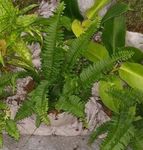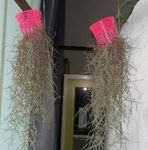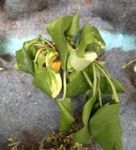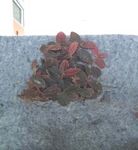INDOOR PLANT SPECIES SURVIVAL UNDER DIFFERENT ENVIRONMENT IN INDOOR VERTICAL GARDEN
←
→
Page content transcription
If your browser does not render page correctly, please read the page content below
International Journal of GEOMATE, April, 2020, Vol.18, Issue 68, pp. 15 - 20 ISSN: 2186-2982 (P), 2186-2990 (O), Japan, DOI: https://doi.org/10.21660/2020.68.5572 Special Issue on Science, Engineering and Environment INDOOR PLANT SPECIES SURVIVAL UNDER DIFFERENT ENVIRONMENT IN INDOOR VERTICAL GARDEN *Sukanya Chaipong1 1 Faculty of Agricultural Technology, Rajamangala University of Technology Thanyaburi, Thailand *Corresponding Author, Received: 13 June 2019, Revised: 19 Nov. 2019, Accepted: 14 Feb. 2020 ABSTRACT : One way to measure the efficacy of a vertical garden is the survival of the plants that cover the growing area, which affects the beauty of a vertical garden. Thus, this research aimed to study the survival of some indoor plant species in with and without air conditioning. We selected plants from 15 families in a total of 20 plant species by review the documents related to the indoor plant and based on duplication of the top 20 plant species, and popular in the market. The study was conducted by incubating in a room with air conditioning (average of temperature and light at 25.6 Celsius and 396.6 Lux, respectively) and without air conditioning (average of temperature and light at 31.9 Celsius and 2,044.1 Lux, respectively), 8 hrs./day average light, watering one time in the initial experiment and noticed the water saturated soil. The survival condition was recorded in 3 levels, namely, the normal condition was 1, the withered condition was 2 and the dead condition was 3. The data was collected for 15 days. The results were 7 species of plants that tolerated both conditioning included as Philodendron 'Moonlight', Aechmea fasciata, Tradescantia zebrina, Chlorophytum comosum, Dracaena surculosa, Tillandsia usneoides and Nephrolepis cordifolia. There were in Araceae, Commelinaceae, Agavaceae, Neprolepidaceae and Bromeliaceae families. Keywords: Indoor plant species, Vertical garden, Plant species survival, Indoor vertical garden 1. INTRODUCTION A living wall with a fabric system is one of the types that is used inside the building. The efficiency Vertical gardens (also referred to as green walls, of this system depends on the water supply system, green façades and living walls) are an important structure, and plants that affect the efficacy of cover factor in improving urban environments [1]. Most and beauty. It was found that 5-10 percent of a plant people in urban society spend 80% to 90% of their in the indoor living wall death and must be planted to time indoors every day [2]. From past studies, it is replace. This high-cost was loss by planted to replace clearly that indoor environmental quality can play an [7]. Considerations for choosing plants depend on important role in work performance, productivity and moisture and light which may not be direct sunlight the health of building users [3]. Plants improved a but it can be light bulbs [8]. Therefore, the efficiency person’s perception of the environment, and a space maintenance of living wall which is the plant occupied with plants was judged to be more selection for an aesthetic and living. This research acceptable than one without plants. There is growing aims to test the survival plants that are arranged in a evidence to support the notion that plants can play an vertical garden, both with air conditioning and important role in providing a higher quality living without air conditioning. This information is useful environment. These is an effective and qualitative for the landscape designers and gardeners for characteristic of an interior-landscaped office [4]. choosing a plant that anesthetic and living to save on In additional, the human body's response was the maintenance cost. showed significant changes when plant conditions varied. These outcomes provided design strategies for 2. MATERIALS AND METHODS incorporating the plants into the interior office spaces and also provided the physiological variables to 1) Establish a vertical garden structure from steel evaluate human comfort in the outside environment material, box size 1.00 x 2.00 meters, choose the type [5]. Evapotranspiration from plants helps lowering of plants that are popularly planted on the vertical the temperature around the planting environment and garden, 23 species, using the planting sheet (Felt) this can be utilized for air cooling and humidity attached to the structure and penetrate the planting control [6]. The limitation on space for landscaping box. Using 4 plants per species, first watering once, by vertical gardening is a more popular choice, and until the soil is saturated with water. also has many benefits, especially improving the urban environment. Nowadays, it is popular both inside and outside the building. 15
International Journal of GEOMATE, April, 2020, Vol.18, Issue 68, pp. 15 - 20 that the book recommends, and also considered the 2.00 meter popularity and available in the market. 23 Plants experimented with 16 Families as shown in Table 1 and 2. The results found both landscape survival conditions were "normal" including Chlorophytum 1.00 meter comosum (Anthesicum Vittatum), Aechmea fasciata, Tradescantia zebrina Loudon (Zebrina pendula Schnizl.), Philodendron 'Moonlight', Dracaena surculosa, Nephrolepis cordifolia and Tillandsia usneoides, which are in family of Bromeliaceae Commelinaceae Araceae Agavaceae Fig1 . Size Box Neprolepidaceae and Bromeliaceae, respectively. On the other hand, Fittonia albivenis, Pilea cadierei, 2) Place in the interior of the building with air Lectranthus scutellarioides and Cuphea hyssopifolia conditioning and without air conditioning turned to died in both conditions, which are in family of the east, both conditions. Acanthaceae Urticaceae Labiatae Lythraceae, 3) Recording data for 15 days by temperature and respectively. Further, it was found that withered light (Light intensity meter model TM-213 plants in both conditions, Platycerium holttumii, TENMARS), which 3 times daily at 9.00 am. ,12.00 Asplenium nidus, Syngonium podophyllum, and am. and 16.00 am. and also the survey record in Epipremnum aureum, which are the family of survival landscape (The survival landscape is the Polypodiaceae, Aspleniaceae, Araceae, respectively. survival plants, which beauty in landscape visibility.) In additional Pellionia repens (Lour.) Merr was was representative 1 as normal, 2 as withered (With found dead in air condition but the normal condition more than 50% withered leaves of the leaves) and 3 in without air conditioner, which belongs to the as dead. Urticaceae and also two species are Ophiopogon japonicus (Convallariaceae) and Chlorophytum comosum (Anthesicum Picturatum) (Liliaceae), which died in air conditioning but withered in the without air conditioning. Moreover, there are two types of Araceae; Epipremnum aureum 'Marble Queen' and Philodendron erubescens K.Koch & Augustin ‘Lemon Lime’, and Dischidia ‘White Diamond’ (Apocyneceae), there were normally in air 3 = Died 2 = withered 1 = Normal conditioning but withered in without air conditioning. On the other hand, it was found two species; Fig. 1 Survival landscape status Peperomia obtusifolia (Piperaceae) and Episcia spp. & Hybrid (Gesneriaceae) which is withered in the air 4) Using the data to analyze with descriptive conditioning and normally in the without air statistics and interpretation of values obtained from conditioning. the average survival conditions in the landscape, there It can be seen that found to survive both was 1.00 - 1.67 means normal, 1.68 - 2.33 means conditions is Araceae but found that some species withered and 2.34 - 3.00 means death. Comparing the withered in both conditions in this family include survival conditions of both plant conditions with the Syngonium podophyllum and Epipremnum aureum. Chi-Square hypothesis test. Pellionia repens (Lour.) Merr. and Pilea cadierei is in the Urticaceae, were died in both conditioning, but 3. RESULTS Pilea cadierei survived without air conditioning. The air-conditioned rooms have a “dead” plant rather than in a room without air conditioning. While in a room 3.1 Survival Landscape Survey Results without air conditioners were found less "withered" plants and also "dead" plants condition than rooms Based on the study of ornamental plants that are with air conditioning. suitable for use in vertical garden, comprising 16 families [9]-[11] including Araceae, Aspleniaceae, Liliaceae, Commelinaceae, Bromeliaceae, Labiatae, Polypodiaceae, Urticaceae, Gesneriaceae, Apocynaceae, Acroleanidae, Neprolepidaceae, Convallariaceae, Lythraceae, Piperaceae and Agavaceae. There were chosen 23 species of plants 16
International Journal of GEOMATE, April, 2020, Vol.18, Issue 68, pp. 15 - 20 No. Scientific name Family name 9 Chlorophytum comosum Liliaceae (Anthesicum Vittatum) 10 Aechmea fasciata Bromeliaceae 11 Tradescantia Commelinaceae zebrina Loudon (Zebrina pendula Schnizl.) 12 Philodendron 'Moonlight' Araceae 13 Dracaena surculosa Agavaceae Chlorophytum comosum) (Aechmea fasciata) 14 Nephrolepis cordifolia Neprolepidaceae 15 Tillandsia usneoides Bromeliaceae 16 Ophiopogon japonicus Convallariaceae 17 Pellionia repens (Lour.) Urticaceae Merr. 18 Chlorophytum Liliaceae comosum (Anthesicum Picturatum) 19 Epipremnum Araceae aureum 'Marble Queen' (Tradescantia zebrine) (Dracaena surculosa) 20 Philodendron Araceae erubescens K.Koch & Augustin ‘Lemon Lime’ 21 Dischidia ‘White Apocyneceae Diamond’ 22 Peperomia obtusifolia Piperaceae 23 Episcia spp. & hybrid Gesneriaceae Table 2 landscape survival status in air-conditioning (Philodendron 'Moonlight') (Nephrolepis cordifolia) Air condition room (Temperature average 25.6) No. Plant species landscape Mean- survival SD ing �) status ( 1 Fittonia albivenis 2.69 0.24 D 2 Pilea cadierei 2.40 0.26 D 3 lectranthus scutellar (Tillandsia usneoides) 2.58 0.26 D ioides Fig. 2 Survival landscape plants in both condition 4 Cuphea hyssopifolia 2.47 0.27 D 5 Platycerium w Table 1 23 Plant species of experimented 1.76 0.14 holttumii 6 Asplenium nidus 2.32 0.26 w No. Scientific name Family name 7 Syngonium w 1 Fittonia albivenis Acanthaceae 2.24 0.24 podophyllum 2 Pilea cadierei Urticaceae 8 Epipremnum aureum 2.30 0.23 w 3 lectranthus scutellarioides Labiatae 9 Chlorophytum 4 Cuphea hyssopifolia Lythraceae comosum 5 Platycerium holttumii Polypodiaceae 1.00 0.00 N (Anthesicum 6 Asplenium nidus Aspleniaceae Vittatum) 7 Syngonium podophyllum Araceae 10 Aechmea fasciata 1.00 0.00 N 8 Epipremnum aureum Araceae 11 Tradescantia N 1.00 0.00 zebrina Loudon (Zeb 17
International Journal of GEOMATE, April, 2020, Vol.18, Issue 68, pp. 15 - 20 Air condition room Without air condition (Temperature room average 25.6) (Temperature No. Plant species average 31.9) landscape No. Plant species Mean- survival SD landscape ing Mean- �) status ( survival SD ing rina �) status ( pendula Schnizl.) 4 Cuphea hyssopifolia 2.57 0.77 D 12 Philodendron 'Moon N 5 Platycerium w 1.00 0.00 2.20 0.51 light' holttumii 13 Dracaena surculosa 1.48 0.13 N 6 Asplenium nidus 2.08 0.86 w 14 Nephrolepis N 7 Syngonium w 1.00 0.00 1.77 0.73 cordifolia podophyllum 15 Tillandsia usneoides 1.00 0.00 N 8 Epipremnum aureum 2.00 0.93 w 16 Ophiopogon 9 Chlorophytum N 2.34 0.27 D japonicus comosum 1.60 0.51 17 Pellionia repens (Anthesicum 2.47 0.21 D Vittatum) (Lour.) Merr. 18 Chlorophytum 10 Aechmea fasciata 1.15 0.58 N comosum (Anthesicu 2.54 0.17 D 11 Tradescantia N m Picturatum) zebrina Loudon (Zeb 1.40 0.51 19 Epipremnum rina aureum 'Marble 1.67 0.17 N pendula Schnizl.) Queen' 12 Philodendron 'Moon N 1.40 0.51 20 Philodendron N light' erubescens K.Koch 13 Dracaena surculosa 1.53 0.52 N 1.11 0.06 & Augustin ‘Lemon 14 Nephrolepis N Lime’ 1.13 0.52 cordifolia 21 Dischidia ‘White N 15 Tillandsia usneoides 1.23 0.42 N 1.00 0.00 Diamond’ 16 Ophiopogon 22 Peperomia w 2.20 0.94 w 1.77 0.20 japonicus obtusifolia 17 Pellionia repens 23 Episcia spp. & w 1.62 0.31 N 1.77 0.20 (Lour.) Merr. hybrid 18 Chlorophytum w Note: D is died, W is withered, and N is Normal comosum (Anthesicu 1.98 0.93 m Picturatum) Table 3 landscape survival status without air- 19 Epipremnum w conditioning aureum 'Marble 1.93 0.88 Queen' Without air condition 20 Philodendron w room erubescens K.Koch (Temperature 1.68 0.71 & Augustin ‘Lemon No. Plant species average 31.9) Lime’ landscape 21 Dischidia ‘White Mean- 1.83 0.94 w survival SD Diamond’ ing �) status ( 22 Peperomia N 1 Fittonia albivenis 2.73 0.59 D 1.52 0.59 obtusifolia 2 Pilea cadierei 2.57 0.67 D 23 Episcia spp. & N 1.52 0.59 3 lectranthus scutellar hybrid 2.35 0.88 D ioides Note: D is died, W is withered, and N is Normal 18
International Journal of GEOMATE, April, 2020, Vol.18, Issue 68, pp. 15 - 20 landscape survival status 3 2.34 1.68 1 2 3 4 5 6 7 8 9 10 11 12 13 14 15 16 17 18 19 20 21 22 23 1.02 0.36 -0.3 Air condition room Without air condition room Fig. 3 Comparison plant survival landscape plants in both condition Note: horizontal axis means No. of plant name vertical axis means survival landscape of plant species, 1.00 - 1.67 means normal, 1.68 - 2.33 means withered, 2.34 - 3.00 means death 3.2 Hypothesis Results the experiment was at the level that humans and plants are occupant comfort but a relative humidity Comparison of survival landscape of plant species that likely to be more maintained to good foliage in each condition was found that each plant is not health. As corresponds to the results of the air different in both conditions of a survival landscape. condition room which the lower relative humidity, There were the same results as 0.317, therefore it was was “dead” plant rather than in another. accepted the main hypothesis that each plant not The study was found that the plants survival significantly different at the level of 0.05 of survival landscape both conditions are Tradescantia zebrina landscape. Based on the main hypothesis that plants Loudon (Zebrina pendula Schnizl.) of the are in the air-conditioning and without air- Commelinaceae family which is a plant with crater conditioning have no difference in a survival and leaf similar to succulent characteristics. landscape. It is found that significance at 1.88, According to the study Gunawardena K. and therefore both conditions had no difference in a Steemers K. [16], one of the most popular plants is survival landscape of a significant level at 0.05. succulent plants. This corresponded to Rochanavibhata [17] found that indoor shrub plants DISCUSSION that are resistant to low-light environments or light frenzy are mostly succulent plants. The family is Light temperature and relative humidity were similar to succulent plants namely the Philodendron averaged relative rooms with and without air in the Araceae and the Dracaena surculosa in the conditioning 25.6, 31.9 degrees Celsius, and 396.6, Agavaceae which is Semi-succulent plants [18]. In 2,044.1 lux and 56.45% 51.25%, respectively. There additional plants that tolerate both conditions were was a light average of 8 hours/day. Gunawardena K. Nephrolepis cordifolia in the Neprolepidaceae, and Steemers K. [12] said that the relative humidity Aechmea fasciata and Tillandsia usneoides in the of humans and plants are that occupant comfort in the Bromeliaceae both families are generated with wax room is 20-28 degrees Celsius and 30-50% relative leaf. These plants are suitable for planting in a vertical humidity and also Blanc P. [13] said that some plant garden especially in a living wall. Due to the leaves species selected tend to require high canopy humidity can reduce dehydration and also reduce the capture of to maintain good foliage health (RH85–95%). This dust “In press” [19]. comfort level RH may present the risk of foliage water stress. Vertical plant canopies however rare CONCLUTION observed to maintain a self-hydrating microclimate that mitigates this risk to an extent. In additional, Although the hypothesis test shown that the survival Jongrungklang N. [14] said that the temperature and landscape conditions of each plant and both humidity in the air is a factor that affects the conditions do not differ at the significance level 0.05. dehydration of plants. This affects the growth process These results of temperature and relative humidity of plants, and Techawongstien S. “In press” [15] says have affected the survival of plants. The indoor that moisture in the air is a low effect on a lot of should have a temperature of 20-28 degrees Celsius dehydration plants. This is consistent with the results and relative humidity of 30-50% so that people and of the study that air-conditioned rooms have a "dead" plants are comfortable. It can maintain good foliage landscape survival rather than in rooms without air health in an indoor vertical garden without air conditioning. Therefore, the relative humidity level in conditioning, which a temperature of 28-32 degrees 19
International Journal of GEOMATE, April, 2020, Vol.18, Issue 68, pp. 15 - 20 Celsius and relative humidity at 85-95%. On the other Environment, Vol. 21, Issue 5, 2012, pp. 642– hand, an indoor vertical garden with air conditioning 650 suggests to Commelinaceae, Araceae, Agavaceae, 9. Flower Ornament Club, Ornamental Plants Neprolepidaceae, and Bromeliaceae. Manual. Bangkok: United Books, 1993, pp 1- From the results, appropriate plants are recommended 138. in the vertical garden (Living wall), which with and 10. Promthong W., Bunnak C. and Chaimongkol C., without air conditioning, including Philodendron Indoor Plotted Plant (2nd edition). Bangkok, 'Moonlight', Aechmea fasciata, Tradescantia zebrina, Pikanesh Publishing, 2000, pp. 103. Chlorophytum comosum, Dracaena surculosa, 11. Bunnak T., Vertical Garden Plants (1st edition). Tillandsia usneoides, and Nephrolepis cordifolia. Bangkok: Baanlaesuan Publishing, 2012, pp 1- 129. ACKNOWLEDGEMENTS 12. Giordanoa R., Montacchinia, E., Tedescoa, S. and Peronea, A Living Wall Systems: a Thank you to the Faculty of Agricultural Technology, technical standard proposal. Energy Procedia, Rajamangala University of Technology Thanyaburi 2017, Vol. 111, pp. 298 – 307. for the research budget. 13. Blanc P., The Vertical Garden: from Nature to the City (Revised Ed), W.W. Norton, New LITERATURE CITED York, 2012, pp. 208. 14. Jongrungklang N., Crop growth modeling: a 1. Ling C.Z. and Ghaffarian H.A., Greenscaping novel way to supplement conventional trial. buildings: amplification of vertical greening KHON KAEN AGR. J., Vol. 41, Issue 3, 2013, towards approaching sustainable urban pp. 359-368. structures. J Creative Sustain Archit Built 15. Techawongstien S., Factors Affecting Plant Environ, Vol. 2, 2012, pp. 13-22. Growth and Development, Horticultural field, 2. U.S. Environmental Protection Agency, Report Department of Plant Science and Agricultural Resources, Faculty of Agriculture, Khon Kaen to Congress on indoor air quality: Volume 2. Universit, 2017, Available EPA/400/1-89/001C, Washington, DC, pp. Source: https://ag.kku.ac.th/suntec/134/134101 250. 20%101Factors%20affecting%20G- 3. Bluyssen, PM. Roda, C. Mandin, C. Fossati, S., D%)20note).pdf, August 1, 2017, pp. 1-37. Carrer, P. de Kluizenaar, Y. Self-reported health 16. Gunawardena K. and Steemers K., Living walls and comfort in ‘modern’ office buildings: first in indoor environments. Builtding and results from the European Official study. Indoor Environment, Vol. 148, 2019, pp.478-487. Air 2016, Vol. 26, pp. 298–317. 17. Rochanavibhata S., Plant Roofing Plates to help 4. Candice A. Shoemaker, K. Randall , P. Diane reduce heat. Independent Study, Master of Relf, and E. Scott Geller. Relationships between Architecture, Department of Architecture, Plants, Behavior, and Attitudes in an Office Kasetsart University, Bangkok, Thailand, 2008, Environment, HortTechnology, Vol. 2, Issue 2, pp.25. 1992, pp. 205-206. 18. Chayamrit K., Key Characters of Plant Families 5. Qin, J., Sun, C., Zhou, X., Leng, H., LIan, Z. No.3. Forest and Plant Conservation Research The Effect of Indoor Plants on Human Comfort, Office, Department of National Parks, Wildlife Indoor and Built Environment, Vol. 23, Issue 5, and Plant Conservation. 90 pages, 2008, pp 1- pp. 709–723. 90. 6. Armijos Moya, T., van den Dobbelsteen, A., 19. Shackleton K., Bell N., Smith H. and Davies L., Ottele, M., & Bluyssen, P. M., A review of green The role of shrubs and perennials in the capture systems within the indoor environment, 2019, and mitigation of particulate air pollution in Indoor and Built Environment 2019, Vol. 28, London, Centre for Environmental Policy, Issue 3, pp. 298–309. Imperial College London, 2012, Available 7. Pérez-Urrestarazu L., Fernández-Cañero R., Source:https://www.tfl.gov.uk/cdn/static/cms/d Franco-Salas A. and Gregorio E., Vertical ocuments/role-gi-pmpollution.pdf, August 1, greening systems and sustainable cities. Journal 2017, pp. 1-32. of Urban Technology, Vol. 22, Issue 4, 2015, pp. 65-85. Copyright © Int. J. of GEOMATE. All rights reserved, 8. Fernández-Cañero R., Urrestaraz, LP. and Salas including the making of copies unless permission is FA., Assessment of the Cooling Potential of an obtained from the copyright proprietors. Indoor Living Wall Using Different Substrates in a Warm Climate, Indoor and Built 20
You can also read



























































